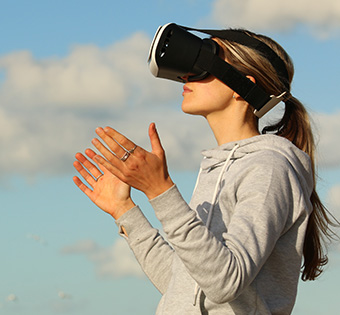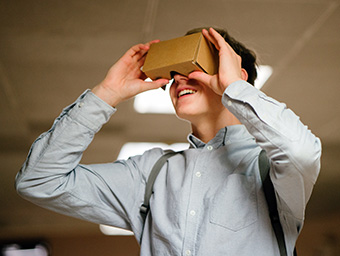 We’ve all heard the hype of VR: “It will replace filmmaking as we know it.” Balderdash. VR will no more replace traditional filmmaking than TV replaced movies. Or that streaming services will replace the broadcast networks.
We’ve all heard the hype of VR: “It will replace filmmaking as we know it.” Balderdash. VR will no more replace traditional filmmaking than TV replaced movies. Or that streaming services will replace the broadcast networks.
They will co-exist; albeit uneasily. Instead, the key thing I learned is that VR doesn’t need to “replace” something in order to be successful. Social media didn’t need to replace something to attract an audience; all it needed to do was showcase its innate strengths.

Those of you who have listened to my interviews on the Digital Production Buzz podcast know that I am skeptical about VR. However, over the last two weeks prepping my “Introduction to 360/VR” webinar, I had a chance to rethink my opinions on VR.
And, I think that we are asking VR the wrong questions. Instead of asking: “How will you replace film?” we need to ask: “What do you do well?” Yes, you can take any camera underwater, but you’ll have the most success if you use a camera that is designed for underwater shooting.
So, let us ask: What is VR designed to do really, really well?
And the answer is that it puts the viewer right in the middle of an experience. This is no small thing, it’s something that film has to work very hard to recreate. If we focus on the experience, rather than the story, we start to discover ways to work with 360/VR that also lead into the strengths of most filmmakers.
WHY SHOULD WE CARE?
If you have more clients and projects than you can handle, you don’t need VR. However, if paying projects are scarce on the ground, or your existing clients are asking: “What can you do for me that’s NEW?” VR can be a useful addition to your portfolio. Ignore, for the moment, whether we can tell stories with 360/VR. Focus, instead on whether you can make money from it.
360/VR doesn’t replace what you are doing now. It supplements it in a variety of complimentary and divergent ways. We already know the techniques and technology of standard digital media production. We just need to master a new way to deliver content.
There are three types of VR:
Within 360° VR, there are four additional terms you need to know:
I want to focus on this last type, 360/VR, because it has the most relevance for filmmakers. We refer to this a VR, “virtual reality.” But, actually, there’s nothing “virtual” about it – any more than shooting a video creates “virtual reality.” We are using traditional video cameras to record a different way to represent the world we live in. And in such, there’s opportunity for traditional filmmakers.
STRENGTHS AND WEAKNESSES

Let’s start with the strengths of 360/VR:
However, 360/VR also has significant weaknesses:
The closest example I can think of to describe 360/VR is not film but theater-in-the-round:
My biggest hurdle in thinking about 360/VR was shifting from seeing the world through a frame, to watching something happen from the middle of a sphere. In film, we move the camera to the edges to get good shots. With VR, the camera goes dead-center.
My second biggest hurdle was that, with video, we control what the audience sees by where we point the camera. With VR, we are building an environment which allows the audience to look anywhere.
The technology of 360/VR uses the craft of film and video production; but its content takes its craft from the stage. When working with 360/VR, we need to use the tricks of stagecraft, not film production, to make sure the audience sees what we want them to see, when we want and where we want.
THOUGHTS ON PRODUCTION

I’m not an expert on shooting 360/VR. But, based on my experiences shooting VR for my webinar, I’ve learned a number of lessons:
SUMMARY
VR was initially pitched as a replacement for traditional filmmaking – principally to generate initial interest in the format. But, VR isn’t film. Worse, thinking that VR IS film forces the format to be what it isn’t.
But what 360/VR can do really well, is put the viewer in the center of an activity and enable them to have the experience of actually being there. This ability to create experiences is yet another tool we can offer to clients or use to develop new programs directly for our own audiences.
NOTE: To learn more about what I learned about 360/VR, watch this webinar.
As always, I’m interested in your comments.
4 Responses to Thoughts on Using 360/VR Successfully
In my interpretation of narrative film-making, 180-degree monoscopic makes way more sense to me than 360; I can think of it as just another wide-screen format like VistaVision or Cinerama, and compose a frame and shooting/editing style that takes advantage of that wider view.
When I finally got to see “The Other Side Of The Wind”, Orson’s long-unfinished project, it struck me as the kind of movie that might have worked better in VR, where the audience could choose which of three narrative threads to follow, and follow a different storyline each time. Robert Altman-type movies might also work for this.
But otherwise I’m still pretty skeptical: I don’t know that 360 is a particularly useful or superior format for telling -every- kind of story. As film-makers, our entire craft is about constructing -one- particular view of an event and taking the audience along on that -particular- ride. Like in still photography, what makes an average landscape suddenly amazing and focused in it’ message is entirely about where you crop the frame. We pay to have our perceptions manipulated in a particular way as an artistic expression. My ego prefers that *I* control the perspectives, the cropping; not the audience.
In such cases, the rest of what’s going on outside the narrative frame is irrelevant – worse; a likely distraction. I can even imagine that It can ruin or make difficult, certain kinds of film-making, like a horror genre’, where the fear and excitement in a key scene is from something just off-screen, invisible to the audience. In 360 there isn’t necessarily that same limitation, so you’d have to work to build the suspense another way. That could end up being a superior way, or not. Can’t tell, yet.
It seems to me too that 360 is really more of a solitary, individual viewer experience than something for a group audience to experience as a collective, in a theater, though for something like a motion ride attraction it does obviously seem to work.
360 puts a LOT more work on passive viewers to decide where to look and when. With their POV free-floating, and self-directed, it’s nearly impossible to be sure they’re looking at a precise thing at a precise time unless you take their control away and slew the view yourself, or use a heck of a lot of lighting and sound cues. That really screws me up as a storyteller.
A stage director can construct the scene so it plays okay regardless of the audience line of sight and angles… but it’s really a very different kind of story-telling art form than film. If you think back to the earliest uses of motion picture film, at first they just planted a camera in the audience seats, front row center of a theatre, and recorded a play from one fixed angle wide shot. Each time you watched that one wide shot, you could choose what action on the stage to follow and when. But it wasn’t until we learned to move the camera around and make cuts to actively direct the eye that film-making really became it’s own unique art form. To me, 360 and 180 is almost a retrograde advancement back towards just setting a stage with a wide shot and leaving the interpretation completely to the viewers. Back to the future, indeed.
Hi Larry,
Wondering about your thoughts on using this 360 VR technique with environmental tour videos. Like a host and guest on location near a lake or water and discussing the area around them. For instance, discussing an area in front of them- but behind the physical camera– and instructing the viewer to turn their view to see that area. In the course of the entire video, the host and guest would visit a few locales and provides information about each locale. What do you think? Might work? Or what…
Al:
This would work. Just don’t have your talent stand still.
Park the camera to show the environment, then have host and guest on wireless mics walking around and commenting on stuff.
Larry
I haven’t thought of this but now that you mentioned it, VR can really co-exist with traditional filmmaking. However, there will be movies that can be watched on VR only. I don’t think film producers can shoot exactly the same movies for VR and for traditional films.
Thanks for this, Larry! As a filmmaker, I should consider VR’s possibilities.